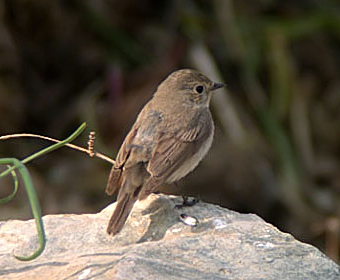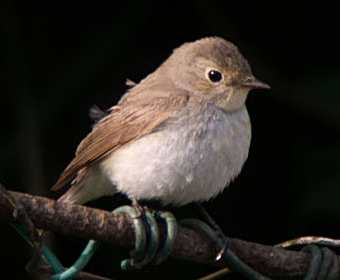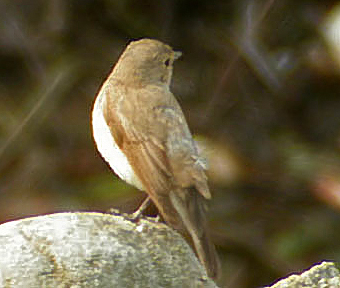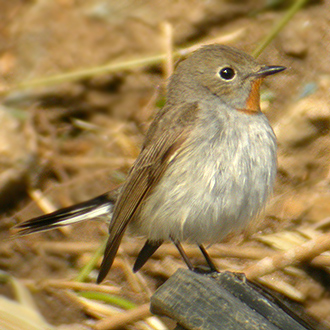Eocheong Island, situated in the Yellow Sea at 36 Degrees 06 North and 125 Degrees 59 East, and approximately 70 km west northwest of the city of Gunsan, is rapidly emerging as THE South Korean migrant hot-spot. April records on Eocheong had already included, amongst many others, South Korea’s first documented Northern House Martin, and second documented Pied Wheatear and Ferruginous Flycatcher.
On April 30th the weather, which had been foggy with heavy rain after several days of bright, sunny conditions, cleared up considerably with the wind swinging to the northwest. Many of the island’s previously-recorded rarities were still present, and new arrivals included a female Daurian Starling Sturnus sturninus, a species considered to be a very rare migrant in South Korea in recent years.
Re-working the island in the afternoon, Nial Moores and Kim Su-Kyung discovered a very worn ficedula on the edge of a paddock. At distance this was assumed to be another Red-throated/Taiga Flycatcher Ficedula albicilla (a scarce migrant, but one that had been recorded a number of times in the previous few days), but it called almost immediately and was straightaway re-identified by Nial Moores as a presumed Red-breasted Flycatcher Ficedula parva. The bird, which had not been present in the morning, stayed only from about 14:30 until 17:00, and was photographed by Nial Moores and Kawaguchi Sentaro. It could not be re-found the next day.

April 30 2003, Photo © Kawaguchi Sentaro

April 30 2003, Photo © Kawaguchi Sentaro

April 30 2003, Photos © Nial Moores

April 30 2003, Photos © Nial Moores

Eocheong Island, April 2003, Photo © Nial Moores
The initial identification of this very worn individual was based on call, which was much softer than the drier calls typical of Red-throated / Taiga Flycatcher. Magnus Robb, an expert on the calls of Western Palearctic birds has previously said that "... it’s worth emphasising how different the calls of parva and albicilla are. I had the benefit of comparing them side by side in India and once I realised how consistent the difference was I could confidently identify them on voice alone. The calls of albicilla sound deeper to me, and its wren-like "trrrr" rattle is drier-sounding, since the individual ticks it’s composed of are much closer together than parva’s: in two examples I compared, the interval between the ticks the rattle is composed of is 58millisec in parva but only 20 millisec in albicilla. No doubt other calls differ too, though I only heard single ticks and rattles from albicilla on the trip....". (Taken from our article on the separation of 1st year Red-throated/Taiga and Red-breasted Flycatchers).
Close and prolonged study of the bird then revealed the following features, all supporting identification as parva:
- the brownish colour of the longest uppertail coverts (matching the tail) - these are black in albicilla;
- the puce-tones to the bill (palest at the base) - the bill is all-dark in albicilla;
- the warmth of the throat and face - cold-toned and greyer in albicilla;
- the paleness of the underparts;
- the warm forehead and buffy tones to the eye-ring;
- and the "cute" facial expression (very similar to a Brown Flycatcher feeding in the same small paddock).
Additional features included the apparently more pointed bill and weaker legs and feet than (most) Red-throated, and the buffy tones to the remaining edges and tips of the tertials.
Although recorded on several occasions in neighboring Japan (especially in winter apparently), this taxon has presumably not been documented in South Korea before.
Ageing such a worn individual is very difficult (though the appearance of pointed tail-feathers would suggest that the bird is not a full adult), and as always we would very much welcome informed comments on both the images and on the statements regarding calls (eg does albicilla ever call like parva?)...



